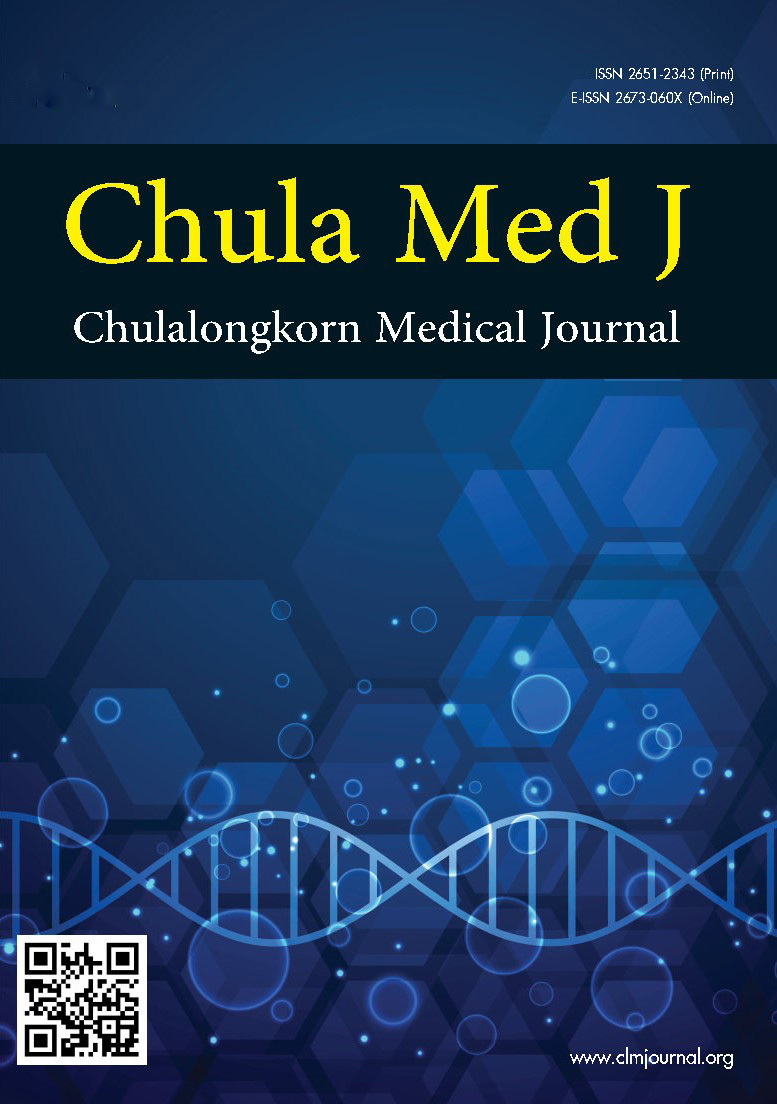Appropriate international normalized ratio follow-up interval for patients with atrial fibrillation taking warfarin
Keywords:
Appropriate follow-up interval, atrial fibrillation, INR, TTR, warfarinAbstract
Background: The recommended follow-up for international normalized ratio (INR) measurement is every 4 weeks in patients with atrial fibrillation (AF) who take warfarin. However, data regarding the appropriate INR follow-up interval are lacking in these patients.
Objective: We aimed to investigate the appropriate INR follow-up intervals in patients with AF receiving warfarin between 6- and 12-week intervals for follow-up appointments.
Methods: We retrospectively enrolled patients with AF taking warfarin at the Central Chest Institute of Thailand between January 2017 and May 2023. The primary outcome was the time in therapeutic range (TTR) for each follow-up interval group, and the secondary outcome was the composite outcome of acute ischemic stroke/transient ischemic attack (TIA)/systemic embolic events, major bleeding, minor bleeding, and/or allcause mortality between the 6- and 12-week groups.
Results: A total of 400 patients with AF taking warfarin were recruited for the study. The average CHA2DS2- VASc score was 3.6 and 3.7 in the 6- and 12-week groups, respectively. The average HAS-BLED score was 1.8 in both groups. The TTR in the 12-week group was not inferior to that in the 6-week group (absolute difference 1.5 percentage points; 95% confidence interval –2.4 to 5.3; P < 0.001 for non-inferiority). In addition, the incidence of acute ischemic stroke/TIA/systemic embolic events, major bleeding, minor bleeding, and/or all-cause mortality was not significant between patients in the 6- and 12-week groups.
Conclusion: The TTR in the 12-week group was not inferior to that in the 6-week group in patients with AF taking warfarin. Thus, an extended 12-week follow-up interval may be applied in clinical practice. A larger prospective study will be required in the future.
Downloads
References
Hindricks G, Potpara T, Dagres N, Arbelo E, Bax JJ, Blomström-Lundqvist CC, et al. 2020 ESC Guidelines for the diagnosis and management of atrial fibrillation developed in collaboration with the European Association for Cardio-Thoracic Surgery (EACTS): The Task Force for the diagnosis and management of atrial fibrillation of the European Society of Cardiology (ESC) Developed with the special contribution of the European Heart Rhythm Association (EHRA) of the ESC. Eur Heart J 2021;42:373-498.
https://doi.org/10.1093/eurheartj/ehaa612
Joglar JA, Chung MK, Armbruster AL, Benjamin EJ, Chyou JY, Cronin EM, et al. 2023 ACC/AHA/ACCP/ HRS Guideline for the Diagnosis and Management of Atrial Fibrillation: A Report of the American College of Cardiology/American Heart Association Joint Committee on Clinical Practice Guidelines. J Am Coll Cardiol. 2024;83:109-279.
https://doi.org/10.1016/j.jacc.2023.08.017
Lip GYH, Banerjee A, Boriani G, Chiang CE, Fargo R, Freedman B, et al. Antithrombotic Therapy for Atrial Fibrillation: CHEST Guideline and Expert Panel Report. Chest 2018;154:1121-201.
https://doi.org/10.1016/j.chest.2018.07.040
Chao TF, Joung B, Takahashi Y, Lim TW, Choi EK, Chan YH, et al. 2021 Focused update of the 2017 consensus guidelines of the Asia Pacific Heart Rhythm Society (APHRS) on stroke prevention in atrial fibrillation. J Arrhythm 2021;37:1389-426.
https://doi.org/10.1002/joa3.12652
Laupacis A, Boysen G, Connolly S, Ezekowitz M, Hart R, James, et al. Risk factors for stroke and efficacy of antithrombotic therapy in atrial fibrillation. Analysis of pooled data from five randomized controlled trials. Arch Intern Med 1994;154:1449-57.
https://doi.org/10.1001/archinte.1994.00420130036007
Bonde AN, Staerk L, Lee CJY, Vinding NE, Bang CN, Torp-Pedersen C, et al. Outcomes among patients with atrial fibrillation and appropriate anticoagulation control. J Am Coll Cardiol 2018;72:1357-65.
https://doi.org/10.1016/j.jacc.2018.06.065
Yamkasikorn J, Methavigul K. Safety and efficacy of non-vitamin K antagonist oral anticoagulants compared with well-controlled warfarin in Thai patients with atrial fibrillation. Asian Biomed (Res Rev News) 2022;16:131-6.
https://doi.org/10.2478/abm-2022-0016
Methavigul K, Chichareon P, Yindeengam A, Krittayaphong R. Net clinical benefit of oral anticoagulants in Asian patients with atrial fibrillation based on a CHA 2DS2-VASc score. BMC Cardiovasc Disord 2023;23:623.
https://doi.org/10.1186/s12872-023-03643-8
Hirsh J, Fuster V, Ansell J, Halperin JL. American Heart Association/American College of Cardiology Foundation guide to warfarin therapy. Circulation 2003;107:1692-711.
https://doi.org/10.1161/01.CIR.0000063575.17904.4E
Schulman S, Parpia S, Stewart C, Rudd-Scott L, Julian JA, Levine M. Warfarin dose assessment every 4 weeks versus every 12 weeks in patients with stable international normalized ratios: a randomized trial. Ann Intern Med 2011;155:653-9.
https://doi.org/10.7326/0003-4819-155-10-201111150-00003
Rosendaal FR, Cannegieter SC, van der Meer FJ, Briët E. A method to determine the optimal intensity of oral anticoagulant therapy. Thromb Haemost. 1993;69: 236-9.
https://doi.org/10.1055/s-0038-1651587
Schulman S, Kearon C. Definition of major bleeding in clinical investigations of antihemostatic medicinal products in non-surgical patients. J Thromb Haemost 2005;3:692-4.
Downloads
Published
How to Cite
Issue
Section
License
Copyright (c) 2025 Chulalongkorn Medical Journal

This work is licensed under a Creative Commons Attribution-NonCommercial-NoDerivatives 4.0 International License.







